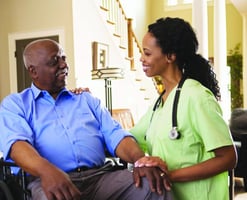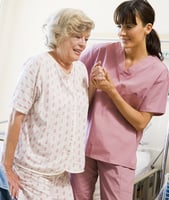After a stay in the hospital, the trip home is welcome. But for patients healing from an injury,...
Home Healthcare 101: Making the Home Safe for Patients
Visiting Nurse Association of Ohio develops customized home healthcare plans for each of its patients. But whether the goal is to provide wound care, monitor vital signs or administer treatment, care plans have one thing in common. They all focus on keeping the patient safe from harm.
For patients recovering at home, safety can mean preventing everything from medication mistakes to toaster burns. But one concern rises above all others.
“The biggest worry… is how to prevent falls,” said Wendy Fishman, director of rehabilitation services for Visiting Nurse Association of Ohio.
When VNA of Ohio’s home care professionals come to a patient’s home for an initial assessment, they take careful notice of everything necessary to provide the best possible care for their patient. In addition to their clinical assessment, VNA of Ohio nurses evaluate the home environment to identify potential hazards.
Better Safety with Home Healthcare
Often, the most seemingly innocuous household objects can set off their alarms, Fishman said. Seen through the eyes of a vigilant VNA of Ohio home care professional, throw rugs aren’t home décor accents as much as they are trip hazards. Loose wires and electrical cords are just waiting to entangle a cane or catch the toe of a shoe.
That console table may have been sitting in the same spot for 30 years, but for a patient recovering from surgery, it becomes a barricade preventing the safe passage from one room to another.
Fishman said VNA of Ohio’s home care team’s thorough safety assessment also includes the patient themself. She said loose-fitting slippers or shoes cause falls, especially if the patient has poor balance.
Home Healthcare Safety Concern: Avoiding Falls
Sometimes, the patient’s medical condition can put them at risk for falls. For example, people with low vision might not see if water has been spilled on the floor. For individuals with diabetes, hard-soled protective shoes should be worn, even while inside, because nerve damage associated with the disease can lead to poor sensory sensation on the bottoms of the feet. The danger is that the patient could step on something sharp and injure their foot without knowing, possibly resulting with infection or more serious problems.
Older patients often deal with poor balance and diminished reflexes and flexibility. All of these issues can lead to falling, so VNA of Ohio rehabilitation therapists develop exercise plans to help them improve in these areas.
Therapists may suggest specialized equipment to make the home safer. Equipment can include everything from a sturdy handrail by the stairs to a basket attached to a walker, where the patient can keep a phone handy in case they may need to call for help.
Bathrooms, the scene of most household falls, are the most dangerous rooms in the house. But, Fishman states, several products exist to help make the bathroom safer for home care patients. Elevated toilet seats and grab bars make it easier to use the facilities independently. Hand-held showerheads and shower seats allow for bathing without having to risk slipping in the shower or falling while trying to get out of the tub.
Call VNA of Ohio Today
Learn more about VNA of Ohio rehabilitation therapy services, or call us today at 1-877-698-6264.



